Studio Visit: Studio Moross
From vibrant illustrations to sexed-up music videos, how this London original tackles the creative industry at large
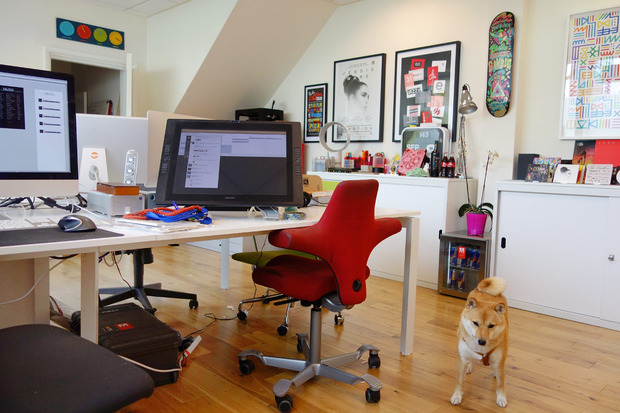
In an industry that has been known to label its constituents with simply one ability or another, the enigmatically artistic Kate Moross is genuinely defining a term that is so often gratuitously applied: Creative. The shift toward owning a diverse skill set is quickly becoming more commonplace among makers and imaginative thinkers, but Moross is surely leading the way—and armed with a vibrant color palette, an eye for seduction and an extreme dexterity for striking visuals, the hard-working London-based artist is setting the benchmark for original, multifarious talent.
Studio Moross‘ achievements span the areas of branding, filmmaking, packaging, print and digital, with music at the heart of most projects. A brief look at her portfolio demonstrates the flexibility in her work—watch any of the music videos Moross directed for Jessie Ware and it’s easy to see her usual penchant for a rainbow of bold colors and geometric shapes is sharply kept at bay in favor of more muted tones and coquettish panning. Moross’ work never ceases to surprise and inspire, so we recently stopped by her Camden studio to learn more about her fascination with color and how she never seems to miss a beat.
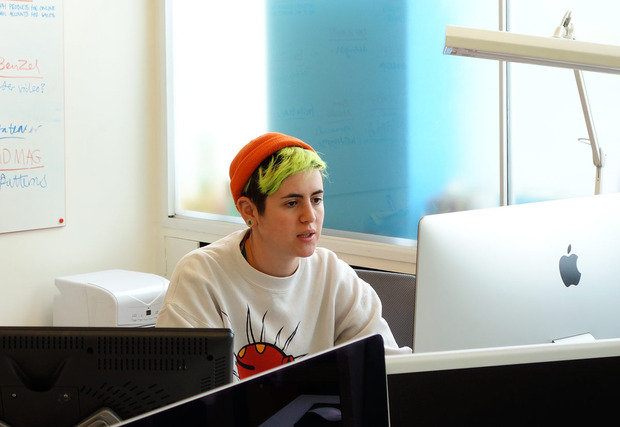
Can you tell us more about the Jessie Ware + Benzel video you shot?
I just worked on another Benzel video which is coming out this week. They’re like a mystery project. I’d like to think they let us do whatever we want but there have been occasions where I’ve done that and they’ve canned what I’ve done so… But that video was such an amazing sort of process because the managers who I work with a lot, PMR, are Jessie’s managers. They kind of called us in like, “Look we’ve got this amazing track and we need a video but we’ve got basically nothing to do it with. Can you just make something sick?” And I was like, “Yeah sure!” [laughs] We literally shot Jessie at the end of a press shoot she was doing, no lights, nothing. We just said, “OK, five seconds Jessie, come on, wrap this vocal.” And she’s so good, she gets it right every time. We shot all of the content ourselves in the studio, with microscopes and stuff. It was really good fun. At the time you’re like, “Oh God, I’m doing all this for nothing,” but then the next time something comes along like that you’re like, “Yeah!”
How did you make the liquid effects?
It’s glitter, paint and oils—different viscosities—shot with a macro lens. The ink sort of falling down was shot by a photographer friend that we work with. I told him the brief: I said, “Go home, shoot the shit out of as many liquids as you can.” Because Jessie had that sort of feel to a lot of her artwork already, but the Benzel artwork had been very colorful, bright, we wanted to bring the two of them together. Those processes are always just super experimental.
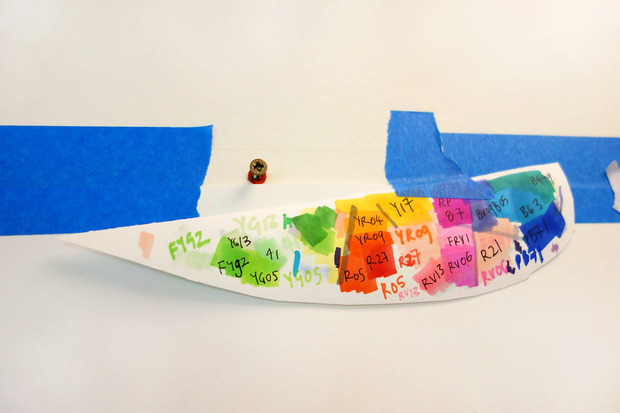
What is it about color that fascinates you so much?
I don’t know, it’s funny because my mum recently said to me, “Do you remember that time we let you paint your bedroom?” I was probably about nine or ten, and she said I could decorate my room however I like. And I bought lime green, magenta, bright blue, bright orange, bright yellow and painted my room a hundred different colors. She’s like, “That is exactly the color palette you use now, isn’t it strange that you’ve had it in you for so long?” But I think London can be quite gray sometimes—or any Western society that’s kind of suits and stuff like that. And also, I think it just makes people feel good to see colorful things, and I like to use color in a way that’s interesting and playful. I just enjoy it, it’s another medium.
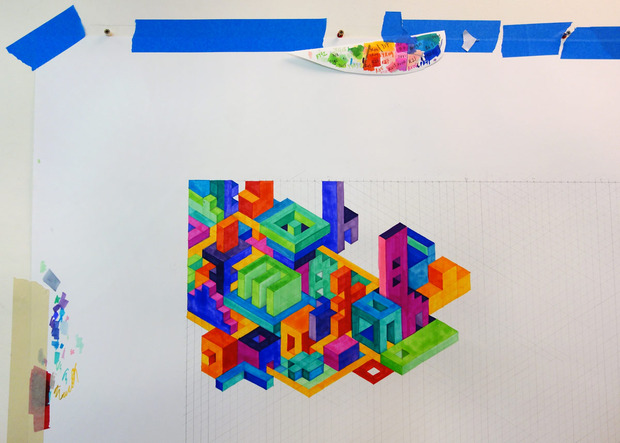
Do you methodically work with color? Or is it more emotional?
I don’t know. It’s difficult to say sort of how and when we make those decisions, but they’re definitely present. It’s just an internal conversation that you’re having with yourself, like, “Oh, maybe I should put more of this here.” It’s really difficult to say. The use of color is something that just comes with experience and lots of trial and error. And then also understanding the perception of it, which is something I studied a lot when I was at art school. There is not necessarily any set of rules, but it’s just a question of your internal conversation. Yesterday I had a whole drama with this picture I’m working on, because I accidentally picked up the wrong purple and used it and I was just like, “Oh no.” The biggest thing about being a creative person, the most important skill is, learning how to cover up your mistakes. Because then they don’t look like mistakes anymore. I spent about two hours yesterday working out how to hide this purple in the picture without having to start again—which I succeeded.
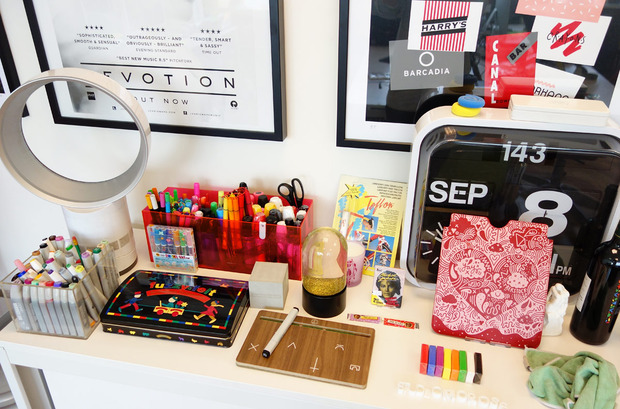
How do you cover up mistakes when you’re using markers, as opposed to paint?
You kind of just have to mix markers together. So I mixed two or three markers together to make it look like another color. But also, there’s no forgiving with pens, you just have to have a mistake. Which is kind of fine, I’m not precious about things. I just let them go, if there’s a mistake there’s a mistake and hopefully it adds character to it.
Do you have to keep using the amalgamated color now?
I have to keep using it. It’s now just part of the work. It took two days just to draw the grids, but after working on this for a bit yesterday, I finally got it to a place where I like it, which means I’m enthusiastic to carry on going, but before then it’s more just like, “OK, let’s just see what it’s gonna look like.” I’ve never ever worked like this before. I do isometric work but only on a computer, I’ve never done it by hand. I’ve done it by hand very loosely, just drawing, but I’ve never done a piece, fully handmade from start to finish—hand-drawn lines, hand-drawn illustration, no plan, just free-styling—that’s very novel for me.
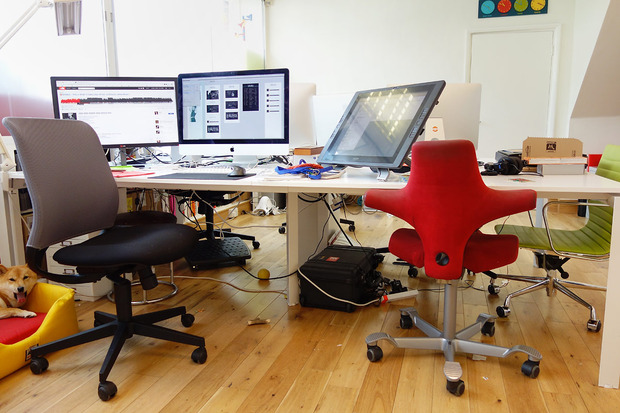
How did you move from doing illustration and graphic design to videos?
It’s kind of weird because, for me, illustration was kind of a “job.” I was studying graphics at school but I had started illustration freelancing around my first year. I just got more and more work, and then more, and then I started doing advertising and actually feasibly making a living out of it. It was hard for me, because I really wanted to do things other than just draw pictures as a career, and the industry can be quite close-minded on what you can or can’t do, like what box you fit in.
I felt kind of pigeon-holed into this illustrator thing, which I fought against quite a lot. Throughout my life there’s been areas like that; I’ve been put in a box and I have to work around it. I kept doing graphics, kept doing illustration and kept them quite separate from each other. And then as the industry and creative world became a bit more open-minded, it started to mix together a bit more. That’s really what I’ve been waiting for. And as for filmmaking, I’ve kind of always been one of those people that says I can do something and people believe me. [laughs] And then I do it and it works and then other people ask me to do it. I think that’s just a bit of luck though, really. And balls, basically. Just like, “You want to make this film? I can make a film.”
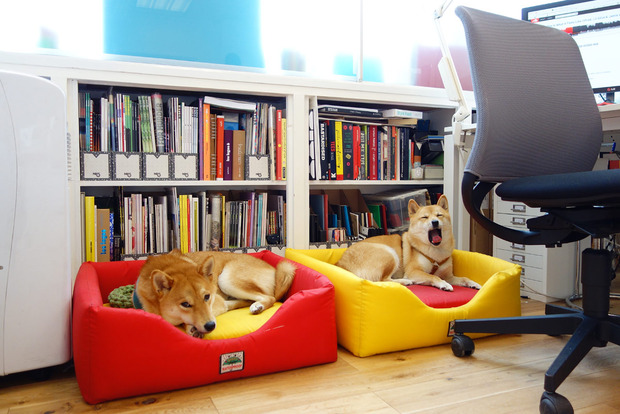
I want to be 80 and building 3D models, I want to be ahead of the curve—or at least understanding it.
Did you teach yourself all of these skills?
Yeah, every technical skill I own is self-taught. I didn’t get taught software at school, I didn’t get taught many things at school, especially art school. Even now I’m teaching myself new software, it’s a never-ending curve of keeping ahead of technology. I feel sorry for creatives that have reached a point where they can’t keep up with technology anymore. I’m just hoping that will never happen to me. I want to be 80 and building 3D models, I want to be ahead of the curve—or at least understanding it. I’m not saying I’m an expert in using Cinema4D or After Effects, but I know my way around a program well enough to do what I want to do. Or to even understand what a professional that I might wanna hire to work on something is doing, so I can talk to them about it too. So that’s something that’s really important to me, and learning software is something I enjoy so I just keep doing it.
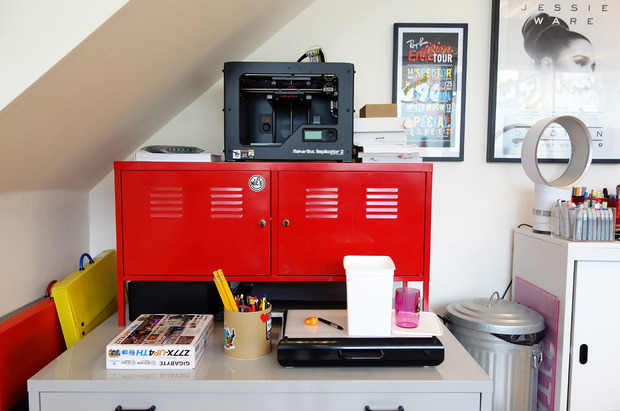
How do you balance client work with room for personal experimentation?
Now that we’ve started this studio, a lot of my day is managing our client base. All of our music clients have regular work, so it depends on where they’re at in their schedule. If they’re in the middle of their album release then there’s a lot of work to do, but if they’re on tour for a bit then we might have a break and work on a new client. The music industry has its own activity periods where it gets really busy, like festival season, then it gets quieter. But I’m trying to make more time for trying new things, and experimenting and committing to things that force me to take time away from the computer. So this piece for the Breed exhibition is an opportunity for me to try out something completely new that I’ve never done before, and I think creating work for shows allows you to do those kinds of things. And then, the studio and I are going away in a couple of weeks just to work on ideas and generate content. We have a very healthy balance of work life but it feels very busy at the moment.
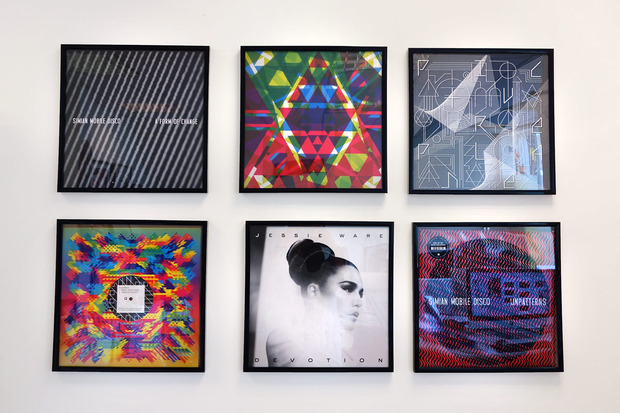
How do you choose who to work with?
Most of our choices are based on, “Is the music good?” Not just, “Is this band cool?” because that’s not really a question for us—it’s our job to make them cool. What’s really exciting is working with new artists, because part of our job as a studio is sort of being like A&R, looking out for music that we can get behind and think that we can make even better through visuals. I really like listening to the artists we work with, and we get to hear stuff before anyone else does, before it’s even mixed sometimes, and that’s really exciting because it makes you feel like you’re part of the industry.
Though entirely different, the Arthur Beatrice video and the Washed Out videos are similar in the way they pan. What do you like about that approach?
I think for me, video is kind of image-making more than storytelling. For some filmmakers storytelling is their reason to make a film, but for me it’s more about reactive imagery to music. That’s kind of my approach to making music videos, and having a variety of approaches is healthy in the industry, because at the moment I feel like it’s heavily narrative-based. There’s a lot of short film-esque music videos, which if they’re done well are great, but in the big spectrum of what MTV used to be in the ’90s, that should only be a fraction and the rest should be much more experimental. So for me I’m using the sort of smaller budget and the more creative artists to experiment really in terms of what will pass as a music video. Everyone is so used to seeing a lead character and a twist, or a suspenseful thing; I’m like “lets just shoot animals up this close and see if people get into it.”
The Washed Out video was in collaboration with Ernest from Washed Out—his ideas and my ideas sort of mixed together. And Arthur Beatrice, their concept was this A-B, male-female singer—almost like they wanted to create a hermaphrodite—that represented the band. We didn’t have CG budget, so my idea was to shoot all of them really macro and create this illusion of a human being that’s made up of all of them. There’s always a concept even if the visual is really simple at the end. I just really like detail shots, color or a lack of color; shadow, shape and form I find interesting because of my background in illustration and graphic design; and camera movements are just essential in those areas otherwise everything’s too static. I’m really glad those videos were well-received, because I worry everyone just wants to watch a short movie, they won’t just sit back and enjoy the psychedelics while listening to the music. From the beginning, with my first-ever music video for Simian [Ghost], it was all about making the music and the visual fit together.
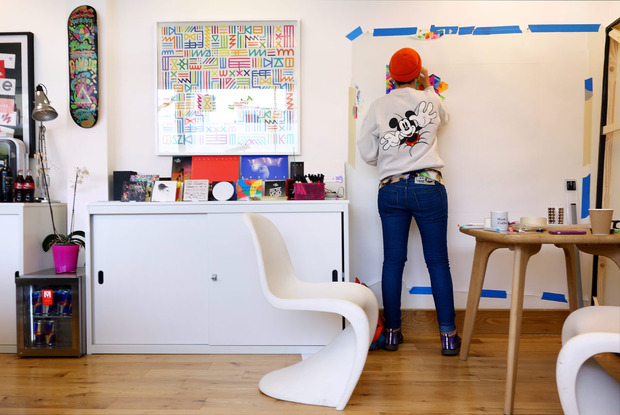
How does all of that sexiness go with triangles and playful shapes?
It’s difficult to explain what things are or how they link together, but in reality they just do. I do lots of different things and I don’t necessarily like to inherently jump between the other. A lot of the time I’m trying to make work that links them just so people can understand; so from here I’m doing isometric drawings, here I’m doing very minimal, classic graphic design, then I’m making psychedelic music videos and then I’m doing hand-drawn type—they’re just separate but in my head they work together.
Do you have a favorite medium?
No. My favorite is doing all of them at the same time. Being able to jump from doing an HTML email to editing a video. And that’s what the studio’s like, we’re constantly shifting between projects and that’s what I enjoy.
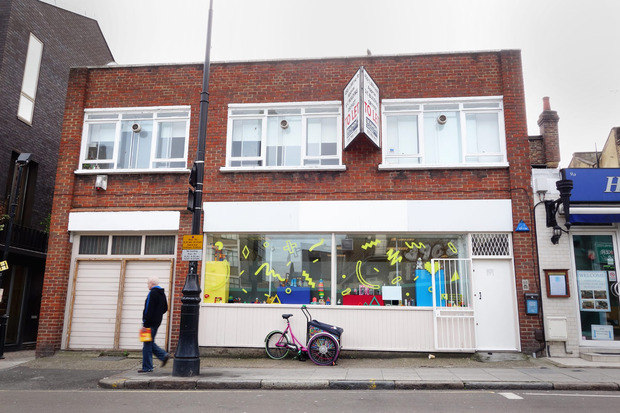
Do you think that London particularly embraces eccentricities and creativity more than say, New York?
I know New York not as well as I know London, but pretty close because I’ve spent so much time out there, but I think London has another level of individuality beyond just not being like everyone else. I think there is, in every society or mainstream culture, a level of rebellion, but London has lots of sub-rebellions. There’s loads of tiny little niches that you can borrow from or fit into. In London I feel like there are even more layers between who you can be and I think we naturally have a lot of eccentric people—not to say fashionably eccentric, I mean genuinely eccentric people, whether it’s the guy who sells coffee beans or the art school student. There is a general kind of acceptance for weirdness that I didn’t really think about, but I don’t get any bother and I look like a clown most of the time, but people are really open-minded. But if you go to the north of England it wouldn’t be the same, you might get some funny looks. But that said, I went to the middle of nowhere, Kerry, in Ireland, and blended in—nobody even blinked an eye at me. So you never know. But you know, people that come to my house would say I was eccentric, but I wouldn’t say I was eccentric.
The Breed Exhibition opens 24 September and runs through 9 October 2013 at the Tramshed—Cock ‘n’ Bull Gallery, London.
See more images in the slideshow.
Photos by Karen Day





















